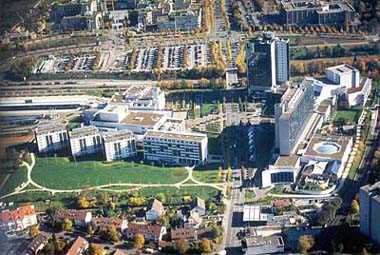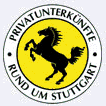
Part of the district of Möhringen are the quarters Möhringen, Fasanenhof and Sonnenberg. With an area of approx. 1,500 ha and around 29,000 inhabitants, Möhringen is one of the largest outer city districts of the federal capital. It is always mentioned as “Moringen” in the first documents that refer to it, hinting at Alemanni colonisation. At first it was the counts of Calw and the Palatinate counts of Tübingen who owned Möhringen, from 1295 it was the Katharinenspital Esslingen. After more than 500 years, Möhringen then became part of the kingdom of Württemberg, first as part of Esslingen then of Stuttgart, and before the Second World War it temporarily became part of Böblingen. Bearing witness to this past is the Spitalhof built in 1469 in which the Heimatmuseum and the Stadbücherei (library) are located. On the 1st April 1942, Möhringen was incorporated with Stuttgart. But even the 60 year affiliation to the federal capital could only slightly blur the grown structures and the independence of this community. With the SI-Centre, Stuttgarts largest leisure and musical project was realised. Not far is the Stuttgarter Pressezentrum. Among others based there are the two big Stuttgart daily newspapers "Stuttgarter Zeitung" and "Stuttgarter Nachrichten". Möhringen characterises itself through a very active community of associations, lively church communities as well as modern social events and infrastructure. There is a large offering of shopping opportunities as well as public places such as secondary schools, an open air swimming pool and an indoor swimming pool. Because of its ideal location for construction on the Filderebene as well as its convenient transport connection to the inner city, to the airport and to the autobahn A8, Möhringen is a popular residential area. Furthermore, many industrial firms and service providers have settled there (Verwaltungszentrale DaimlerChrysler-Konzern, DEKRA, Neoplan, Pressehaus, Hansa, Züblin, SSB-Zentrale), currently offering approx. 36,000 jobs. Despite some international firms having settled there, you can still find the rural idyll in the centre which Möhrigen has kept over the centuries. The quarter of Fasanenhof emerged in the 60s and is mainly residential. The name stems from a pheasant farm which the Duke of Württemberg had built in 1739 in the vicinity of his country house. Möhringen is also known for its Martinskirche which, because of its unusual height, is called “Filderdom”. Built in 1460 and reconstructed in 1853, a large part of the interior was destroyed. Unfortunately it was not rebuilt in its original form and the exterior was only simplified. Private links about Möhringen + Handballverein.







